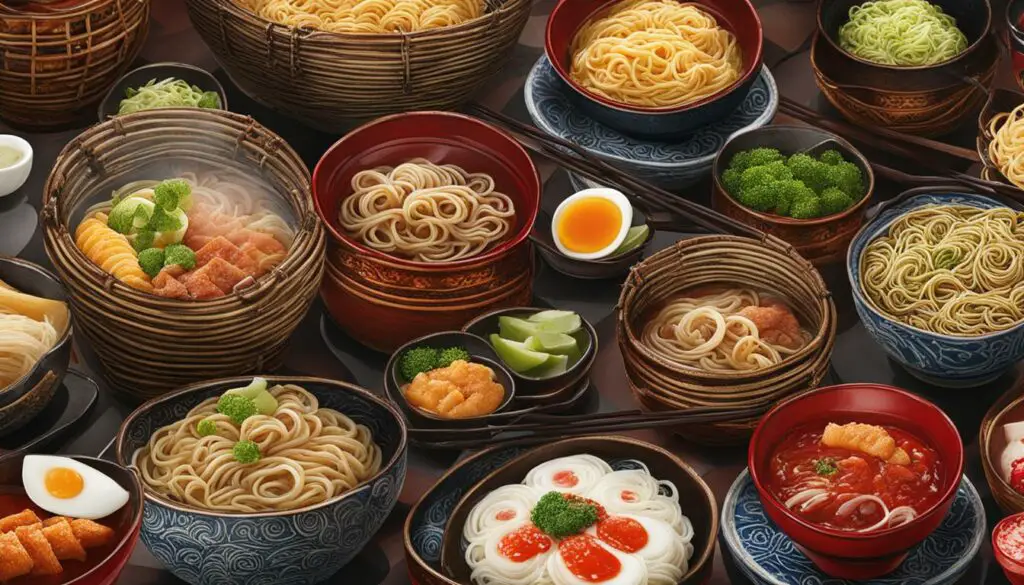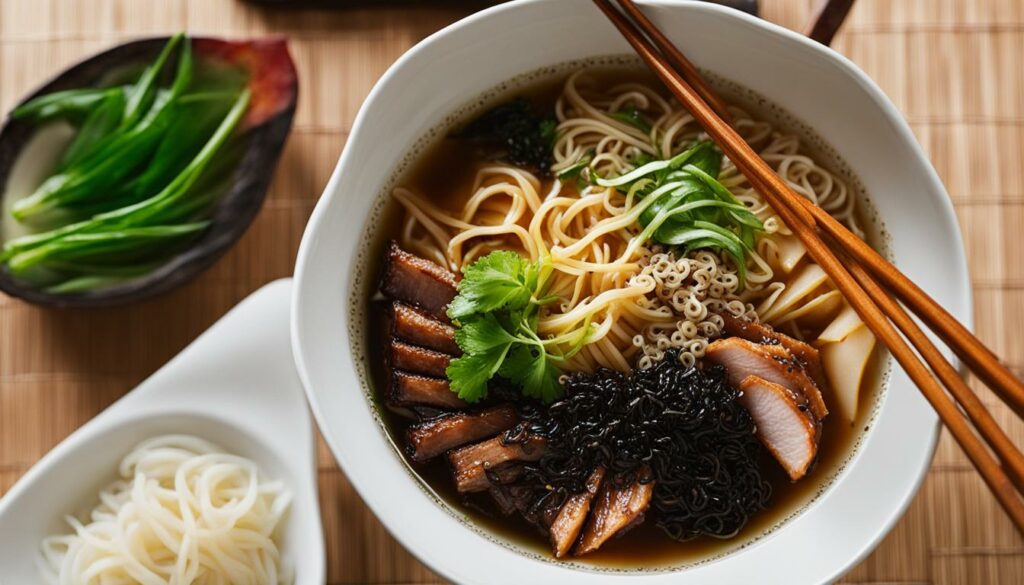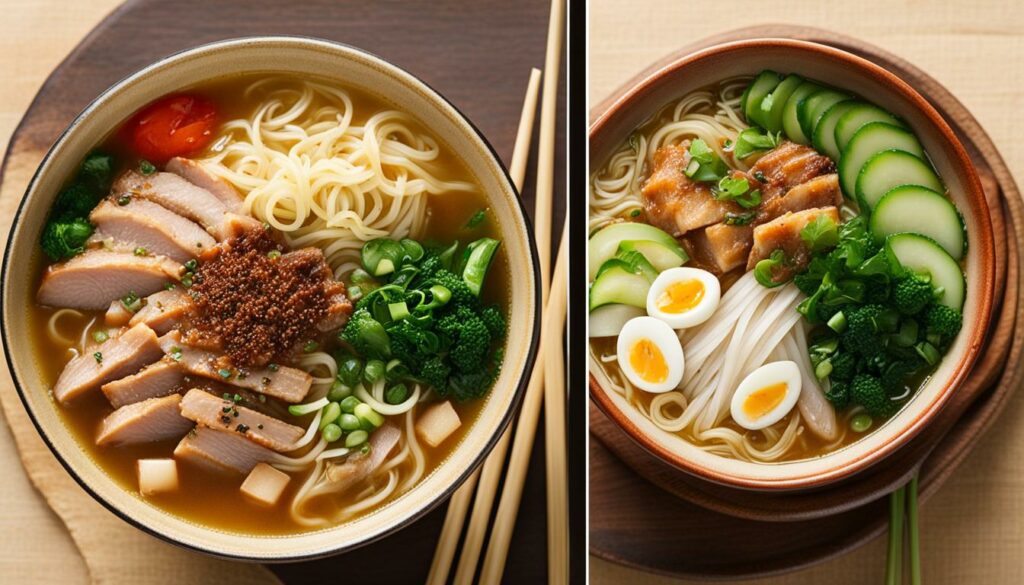If you’re a fan of Japanese ramen, you know that the variety of broths available can be overwhelming. Two popular flavors that often spark debate are Shio and Shoyu. Both offer unique tastes and have their own loyal following.
Shio, which means “salt” in Japanese, is a subtle and delicate broth that uses salt as the main seasoning. On the other hand, Shoyu, which means “soy sauce,” has a bolder flavor derived from the use of soy sauce.
Each broth also has its own special ingredients and preparation techniques that contribute to its distinct flavor profile. But what exactly sets Shio and Shoyu apart from each other? Let’s dive in and explore the differences between these two popular ramen flavors.
Key Takeaways
- Shio and Shoyu are two popular flavors of Japanese ramen
- Shio is a subtle and delicate broth that uses salt as the main seasoning
- Shoyu has a bolder flavor derived from the use of soy sauce
- Each broth has its own special ingredients and preparation techniques
- The differences between Shio and Shoyu contribute to their distinct flavor profiles

Understanding Shio Ramen: A Subtle Salt-Based Delight
When it comes to Shio ramen, the star of the show is undoubtedly the salt. Unlike other ramen broths that rely on soy sauce or miso for their flavor, Shio ramen lets the salt speak for itself.
The key ingredients in Shio ramen are chicken or fish broth, salt, and vegetables like onions, garlic, and ginger. The broth is simmered for several hours to bring out its rich flavor and depth. The result is a light and delicate broth that highlights the natural sweetness of the ingredients.
One of the main differences between Shio and other types of ramen is the color – Shio ramen has a lighter, almost clear broth. It is also typically paired with thinner, straight noodles that complement the subtle flavors of the broth.
The taste of Shio ramen is where the salt shines. It provides a subtle but distinct flavor that brings out the savory notes of the broth. The saltiness is not overpowering, but rather enhances the other ingredients in the dish. It offers a refreshing alternative to the heavier and richer flavors of other ramen varieties.
Overall, Shio ramen is a perfect option for those who prefer a more subtle taste and lighter broth. It is a refreshing change from the usual soy sauce or miso-based broths, and offers a unique flavor profile that is not to be missed.
“When it comes to Shio ramen, the star of the show is undoubtedly the salt.”
Exploring Shoyu Ramen: Unearthing the Umami of Soy Sauce
If you’re a fan of ramen, you’ve probably tried the more popular Shio ramen broth. But have you ever tasted the rich and flavorful Shoyu ramen? This broth is a popular choice among ramen lovers due to its unique umami taste derived from soy sauce, one of its key ingredients.
The preparation of Shoyu ramen is similar to other ramen varieties, using a combination of broth and tare, a concentrated sauce that’s added to the broth. The broth is typically made from chicken, pork or a combination of both, along with vegetables such as onions and garlic.
The tare used in Shoyu ramen consists of soy sauce, sake, mirin, and sugar. This combination of ingredients gives Shoyu ramen its distinctive flavor that’s different from other ramen broths. The soy sauce provides the umami flavor, while the sake and mirin give a subtle sweetness to the broth.
When it comes to toppings, Shoyu ramen is often served with sliced pork belly, green onions, and seaweed. The pork belly adds richness to the dish, while the green onions and seaweed provide a fresh contrast to the savory broth.
Compared to Shio ramen, Shoyu ramen has a bolder and more complex flavor profile. The soy sauce provides a more pronounced umami taste, and the combination of sake and mirin gives it a more well-rounded flavor. If you’re a fan of soy sauce, then Shoyu ramen is definitely worth a try.
Recipe: Shoyu Ramen
“What’s great about Shoyu ramen is that it’s easy to make at home and requires only a few ingredients.”
| Ingredients | Preparation |
|---|---|
| 4 cups chicken broth | Heat in a pot and keep warm. |
| 1/2 cup soy sauce | Combine with 1/2 cup sake, 1/2 cup mirin, and 2 tbsp sugar in a separate pot. Heat until the sugar dissolves. |
| 2 garlic cloves, minced | Sauté in a pan until fragrant. Add 2 tbsp vegetable oil. |
| 2 slices pork belly | Sear in a separate pan until browned. Remove and set aside. |
| 1 pack ramen noodles | Cook according to package instructions. |
| 2 green onions, thinly sliced | Rinse in cold water and set aside. |
| 2 sheets nori seaweed | Cut into small pieces. |
To assemble, divide the cooked noodles between two bowls. Ladle the broth and tare over the noodles. Add the pork belly, green onions, and nori seaweed on top.

Now that you know more about Shoyu ramen, why not give this flavorful broth a try? You might just find a new favorite ramen flavor.
Shio vs Shoyu: A Flavorful Comparison
Now that we have explored the distinct flavors of Shio and Shoyu ramen, it’s time for a head-to-head comparison. Let’s take a deeper look at the differences between these two popular broths.
| Factor | Shio Ramen | Shoyu Ramen |
|---|---|---|
| Broth Base | Simple and delicate salt-based broth | Savory broth made with soy sauce and other seasonings |
| Flavor Profile | Subtle, with a gentle saltiness and a touch of sweetness | Umami-rich with a slightly sweet and salty taste |
| Main Ingredients | Sea salt, chicken or pork bones, vegetables | Soy sauce, chicken or pork bones, vegetables, mirin, sake |
| Preparation Method | Simplicity is key; boiled for a short time to achieve a clear broth | Complex preparation involving simmering the broth for hours with multiple ingredients |
As you can see, the key differences between Shio and Shoyu ramen lie in their broth base and flavor profile. Shio ramen is a simple and subtle broth that relies on the purity and quality of its ingredients. Shoyu ramen, on the other hand, is a more complex broth that includes soy sauce and other seasonings for a deeper and richer umami taste.
When it comes to the main ingredients, both types of ramen rely on chicken or pork bones for their base, but Shoyu ramen includes additional flavors such as mirin and sake for added depth. The preparation methods for both also vary, with Shio ramen being boiled for a short time to achieve its clear broth, and Shoyu ramen simmered for hours with multiple ingredients.
Ultimately, the choice between Shio and Shoyu ramen comes down to personal preference. If you are looking for a delicate and simple broth, Shio ramen is the way to go. But if you crave a more complex and savory flavor, Shoyu ramen is the perfect choice. So go ahead, try both and decide for yourself which one reigns supreme in the world of Japanese ramen.

Conclusion
In conclusion, you have now discovered the distinct flavors and tastes of Shio and Shoyu ramen, two of the most popular broths in Japanese ramen cuisine. Both have their unique ingredients, preparation methods, and loyal followers.
Whether you prefer a subtle salt-based flavor or the umami-richness of soy sauce, ramen has something for every taste bud. There’s nothing quite like a steaming bowl of broth, noodles, and toppings to warm you up on a cold day.
So, the next time you’re craving some delicious ramen, don’t hesitate to try both Shio and Shoyu to see which one you like best. Who knows, you might just end up discovering a new favorite!
With these flavorful broths, there’s no doubt that Japanese ramen is a culinary masterpiece that continues to captivate the taste buds of people all around the world. So, what are you waiting for? Head out to your nearest ramen joint and savor the unforgettable taste of these amazing broths today!
FAQ
Q: What is the difference between Shio and Shoyu ramen?
A: Shio ramen is a salt-based broth, offering a subtle and delicate flavor, while Shoyu ramen derives its taste from soy sauce, resulting in a unique umami experience.
Q: What are the key ingredients used in Shio ramen?
A: The key ingredients in Shio ramen typically include salt, chicken or seafood broth, and various seasonings to enhance the flavor.
Q: How is Shoyu ramen prepared?
A: Shoyu ramen is prepared by combining soy sauce with a flavorful broth, often made from chicken or pork, and then adding toppings such as sliced pork, spring onions, and bamboo shoots.
Q: How do Shio and Shoyu ramen differ from other ramen flavors?
A: Shio ramen stands out for its subtle saltiness, while Shoyu ramen showcases the unique umami taste of soy sauce. These flavors set them apart from other ramen varieties, such as Miso or Tonkotsu.
Q: Which ramen flavor is more popular?
A: The popularity of Shio and Shoyu ramen varies depending on personal preference. Some people prefer the delicate flavor of Shio, while others enjoy the rich umami taste of Shoyu.
Q: Can I customize my Shio or Shoyu ramen?
A: Absolutely! Ramen restaurants often offer various toppings and additions like sliced pork, soft-boiled eggs, seaweed, or corn. Feel free to mix and match to create your perfect bowl of ramen.
Q: Are there vegetarian or vegan options for Shio and Shoyu ramen?
A: Yes, many ramen shops now offer vegetarian or vegan versions of Shio and Shoyu ramen. These options often replace the meat-based broth with a vegetable-based alternative without compromising on flavor.